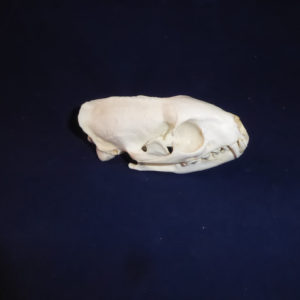Herpestes ichneumon Skull Replica measures 3.9 inches. Herpestes ichneumon Skull replica is museum quality polyurethane cast. Known as Egyptian Mongoose
The Herpestes ichneumon species or Egyptian mongoose also known as ichneumon is a mongoose species native to the coastal regions along the Mediterranean Sea between North Africa and Turkey, tropical and subtropical grasslands, savannas, and shrublands in Africa.
The H. ichneumon species or Egyptian mongoose’s long, coarse fur is grey to reddish brown and ticked with brown and yellow flecks. Its snout is pointed, its ears are small.
The Herpestes ichneumon or Egyptian mongoose is diurnal. In Doñana National Park, single Egyptian mongooses, pairs and groups of up to five individuals were observed.
Adult males showed territorial behavior, and shared their home ranges with one or several females. The home ranges of adult females overlapped to some degree, except in core areas where they raised their offspring.
Herpestes ichneumon or Egyptian mongoose preys on rodents, fish, birds, reptiles, amphibians, and insects. It also feeds on fruit and eggs. To crack eggs open, it throws them between its legs against a rock or wall.
In Doñana National Park, 30 Egyptian mongooses were radio-tracked in 1985 and their faeces collected. These samples contained remains of European rabbit, sand lizards Iberian spadefoot toad, greater white-toothed shrew, three-toed skink, dabbling ducks, Western cattle egret, Wild boar, Algerian mouse and rat species.
Research in southeastern Nigeria revealed that Herpestes ichneumon or Egyptian mongoose also feeds on Giant pouched rats, Temminck’s mouse, Tullberg’s soft-furred mouse, Nigerian shrew, Hallowell’s toad, African brown water snake, and Mabuya skinks.
It attacks and feeds on venomous snakes, and is resistant to the venom of Palestine viper, Black desert cobra, and Black-necked spitting cobra.
In Spain, it has been recorded less frequently in areas where the Iberian lynx was reintroduced.


